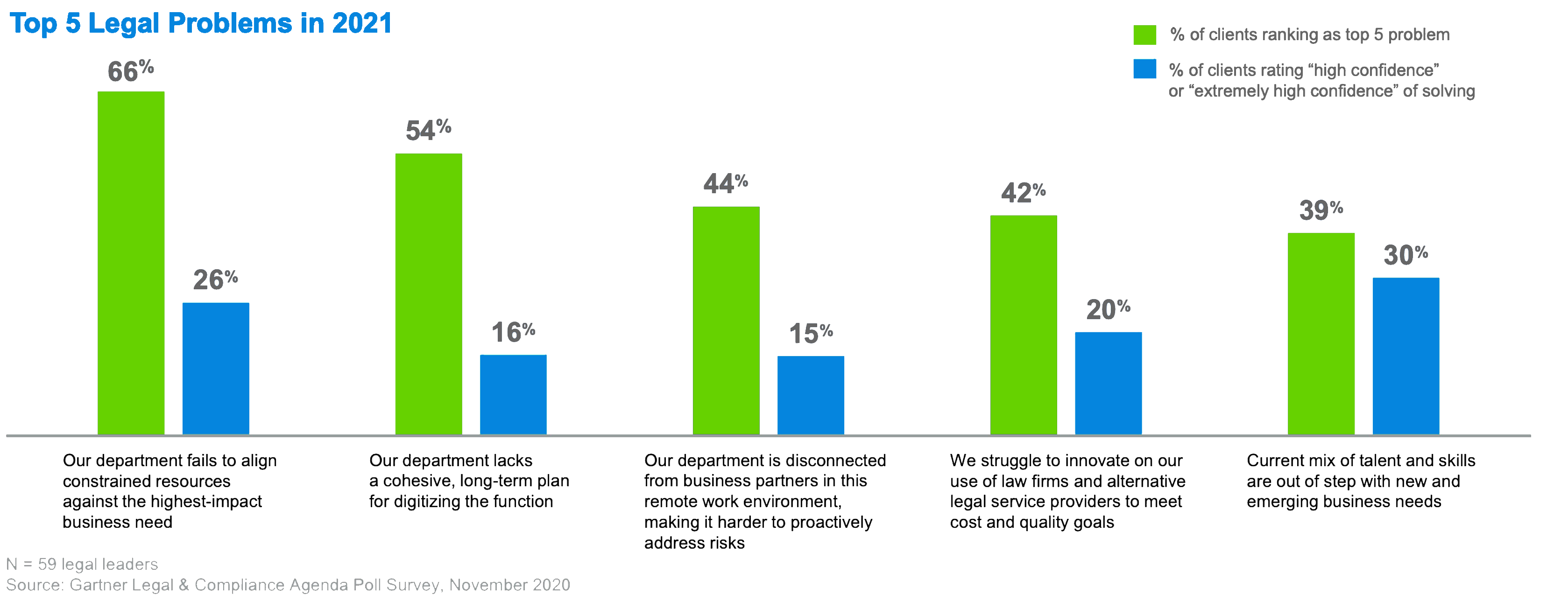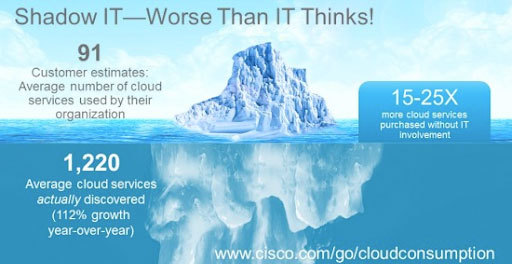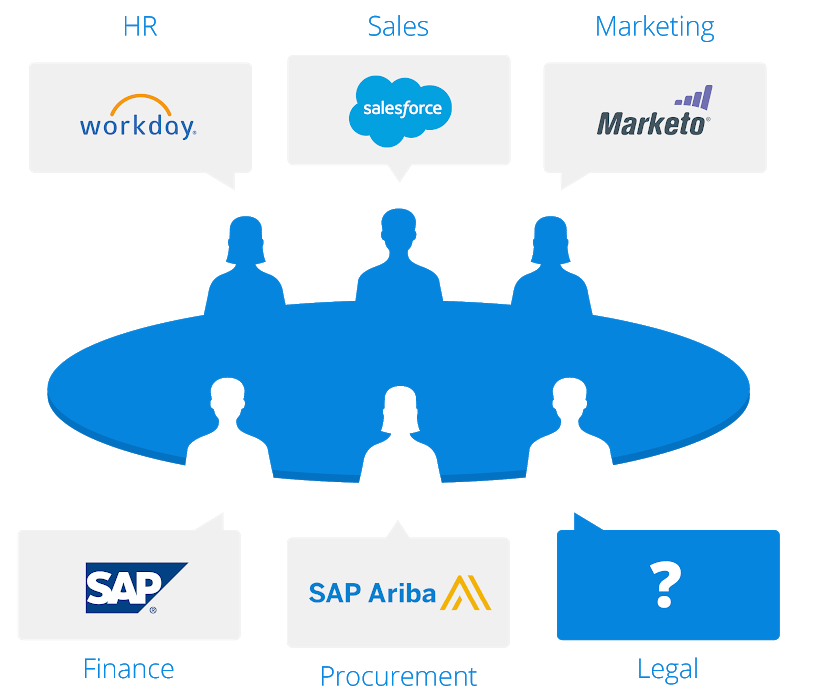The DIY Legal Tech Trap

Andrew Mellett
Founder & Executive Director
Every General Counsel makes mistakes. Most of these mistakes (even when viewed with the benefit of hindsight) are understandable. Being a General Counsel is a fiendishly hard job.
Yet there is one mistake we see come up every year in our conversations with GCs around the world. The outcome is highly predictable, has a large impact - yet strangely it is largely not their fault.
We call it ‘DIY tech’.
Out of the hundreds of times GCs have told us the story of choosing to work with IT to ‘build it themselves’, we have never heard of a single success. Not one.
You may understandably be skeptical of this assertion coming from the CEO of one of the world’s largest Legal Tech vendors. So let me explain further and you can be the judge.
Digitising the Legal function: a new frontier
Research from Gartner’s GC Legal & Compliance practice shows that ‘digitising their function’ remains the second biggest priority and challenge amongst GCs. Indeed, all the top five challenges have a digital problem (or solution) embedded in them.

Digital transformation is a difficult objective for Legal functions to master. Most functions have never adopted technology, and Legal leaders simply can’t know what they don’t know.
Naturally, in navigating this minefield, they turn to their colleagues in IT and fall into one of the biggest traps in the Legal Transformation Doom Loop.
A clash of incentives
Show me the incentive, and I will show you the behaviour - Charlie Munger
IT business partners come to these conversations with two biases: One from the top, and one from the bottom.
The first is the mandate from the CIO to ‘eliminate shadow IT’. In other words, to stop the adoption of new technologies into the business. CIOs, understandably, are concerned that they will be unable to procure, support, integrate, and manage the tsunami of requests for new technology from across the business. In response, they instruct their team to ‘say no’ to any new technology and to drive internal clients to ‘approved solutions’.
If your IT guy says ‘we are a Microsoft shop’ this is really what they mean.

The ‘bottoms-up’ reason is perhaps less obvious. Internal IT guys spend their days doing upgrades, security reviews, vendor management, integrations, and systems maintenance. It’s vastly less interesting stuff than what their friends do in ‘cool start-ups’. It is only natural they get excited about any opportunity to build something that they can put on their CVs.
So the answer from the IT business partner is ‘we can build something for you on Sharepoint, Service Now, or [insert generic IT solution here]’.
So you think “Great! IT is going to handle this for me, and I won’t have to worry about budget”.
Until nine months later when you have invested a huge amount of time…and it doesn’t work.
Why doesn’t it work? The first, the last & the only of software
The first rule of software is that you don’t want to be the first, the last or the only client of a software product. The first - you have to deal with all of the pain of bugs while the vendor irons out user experience issues. The last - you have to deal with a product that is near obsolete. If you had to choose the worst, it would be ‘the only’. If you are ‘the only’ user of a software, you are by default the first, the last and will likely experience the pains of both.
Show me the money
To understand why this is, you first need to understand a little bit about SaaS (Software as a Service) economics.
SaaS at its heart is a ‘shared cost' business model. It’s like purchasing a gym membership. Very few people can afford to build a $3m gym at home, but most people can afford $50 a month to access that value at their local gym.
Every client shares the cost of the development of the SaaS solution and provides feedback to drive its improvement. As a result, every client gets exponential value without any incremental increase in cost.
Indeed, SaaS businesses largely don’t turn a profit - so shareholders of SaaS businesses subsidise the service for the benefit of customers.
Even the largest businesses in the world couldn’t justify Plexus' product development budget. Instead it is shared by companies including Coca-Cola, L’Oréal, Unilever, Pepsi, Woolworths, Total, KFC, Singtel Optus, plus hundreds of the world’s best Legal functions.
If your IT function says they can build it for you. Ask them ‘how many engineers will you put on the project and for how long?’. Building a great product is a journey, not a destination.
It’s not just the money
Even if your business chose to spend the millions of dollars it would cost to re-create our solutions, it would be difficult to synthesise the feedback we receive daily to improve our products and it would be impossible to justify our ongoing investment in R&D.
But the value differential of DIY vs SaaS extends beyond just ‘the product’. Adoption is the silent killer of technology. If you build it yourself, who will do the upgrades? The roll-out? The support? The training? The configuration?
And when the well-meaning IT business partner moves on to his dream job at Canva, Atlassian or Google (or a more important internal project) - who will pick up what they leave behind?
What do you do when IT tells you ‘they can build you something’?
If this is the advice of your IT business partner, Law Firm, or consultant, ask them this: What other key function in the business has built their own system? Does Finance use Sharepoint for their ERP? Does Sales use Access for the CRM? Does HR use Service Now for their HROS?

In a world of ubiquitous best of breed SaaS solutions. The words ‘bespoke’ and ‘software’ should never go together.
As one respected Legal leader said to me ‘you could do your own dentistry…but would you want to?’.
Interested in learning more about legal transformation? Learn about current trends, measuring and communicating legal value and how legal leaders are building influence within their organisations.
The home of your team’s contracts and legal work
Plexus helps everyone in your business execute legal tasks with certainty and speed. Build self-service workflows for routine legal tasks, accelerate your contract lifecycle, and bring clarity + transparency to legal matters.
Request a call-back
One of our consultants will be in touch ASAP to answer your questions and determine your requirements.
Want to speak to someone instead? Call us on 1300 983 907
Thank you
One of our consultants will reach out to you shortly.
Related Content
We use cookies on this site to enhance your user experience and improve our services. By using our website, we assume you're ok with this. View our privacy policy for details.
Get your free eBook!
Modernise your legal function with the Digital Transformation Guide for General Counsels.
Hooray!
The eBook is on its way to your inbox. You can also download via the link below.
Download now